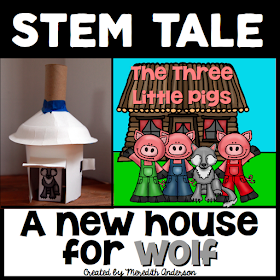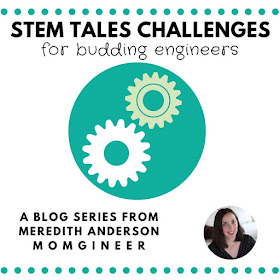How to Run a Successful STEM Tale Activity
If you love STEM challenges (or are interested in trying them) and learn about fairy tales in your classroom or homeschool, why not combine the two together? I have developed several fairy tale STEM activities where the story has been changed slightly so that a STEM component is included. As your children read through the story, they will follow the engineering design process to solve the problem presented. These STEM challenges are a big hit with kids, as they can imagine the story unfolding in their minds. It's also a lot of fun to compare and contrast the traditional story with the STEM tale.Gather Your Materials
Most of my STEM tale challenges only require materials you already have on hand. For this Three Little Pigs challenge, however, you will need a fan to act as the wolf's blow. The wolf won't be blowing the pigs' houses down in this story though! The STEM tale wolf is not nearly as bad as he is described in the traditional fairy tale. He doesn't want to eat the little pigs, but rather he just has some anger management issues. He is upset because the little pigs have their own houses, yet every time wolf builds a house he sneezes and it blows apart! The aim of the challenge is to have the pigs help wolf design a house strong enough to withstand his own sneeze/blow.Other materials needed:
- cardboard
- craft sticks
- tape
- pipe cleaners
- cups
- other recyclables / building supplies you have on hand
A Note Before Starting the Challenge
If your students will not be able to keep their creations, please do let them know ahead of time. One thing I often do, especially if there are fragile prototypes, is to take photographs and then post them in a location everyone can access. That way they can share their creation and describe it to family and friends, but don't have possible upset when it inevitably falls apart or gets destroyed by someone by mistake.Print the Booklet
This booklet not only contains the STEM tale with a twist, it also includes the steps of the engineering design process. Make sure you also print any data recording sheets, rubrics, etc. The children will- discover what the question or problem is (ASK),
- brainstorm one or more solutions to that question (IMAGINE),
- sketch their idea and label it with details (PLAN)
- build and test their prototype and answer questions about it (CREATE)
- adjust or redesign their prototype, retesting if necessary (IMPROVE)
- answer follow up questions about their design or the activity (REFLECT)
Build the Prototype
This will be the most favorite part for a good chunk of your students. You may choose to limit the materials that they use (especially tape, otherwise they will use it ALL). Some of their ideas will work, others won't. They will probably have to modify their design as they work on it. When they are satisfied, they can test their prototype:Of course, it probably won't be perfect the first time. That is why you need to:
Once that has been accomplished and any data sheets are filled out, the students will share what they learned. This is also a great time to think back to the initial idea to see what worked and what didn't, and how you might approach a similar problem in the future. If you are using STEM tales, now is the time to fill out the certificate of completion and the rubric so that students know which tasks they did well and which they can work on next time.
How Much Time Will I Need?
I recommend setting aside an hour to work through the STEM tale from start to finish. Depending on how many kids you have and their reading abilities, it may take a little longer. The story books are written for second graders, but many first graders will be able to work through them as well. Another possibility is if you have reading buddies available to use them. Some of the challenges can be done faster than an hour, but I guarantee once your students start working on their designs, they will have more and more ideas about how to improve them or decorate them! Once you have worked through one or two STEM tales, your kids will be familiar with the process and won't need as much support. If you are doing these with third graders, you can even set them out as a STEM station that they can work through independently. When they have finished, they should present their design to at least one other person and listen to that person's feedback.All of these skills go hand in hand with a growth mindset. If that is something you are trying to incorporate in your classroom, STEM tales are a great way to practically do it!
Here are all the steps in one easy graphic:
If you would like to purchase a copy of this STEM challenge, you can do so by clicking here:
Pin these ideas for later:
To see all blog posts about STEM tales challenges, click here:
Photos by Snapshots by Amy












